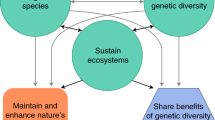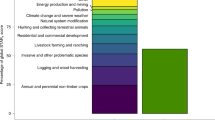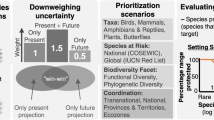Abstract
The Kunming-Montreal Global Biodiversity Framework (GBF) of the UN Convention on Biological Diversity set the agenda for global aspirations and action to reverse biodiversity loss. The GBF includes an explicit goal for maintaining and restoring biodiversity, encompassing ecosystems, species and genetic diversity (goal A), targets for ecosystem protection and restoration and headline indicators to track progress and guide action1. One of the headline indicators is the Red List of Ecosystems2, the global standard for ecosystem risk assessment. The Red List of Ecosystems provides a systematic framework for collating, analysing and synthesizing data on ecosystems, including their distribution, integrity and risk of collapse3. Here, we examine how it can contribute to implementing the GBF, as well as monitoring progress. We find that the Red List of Ecosystems provides common theory and practical data, while fostering collaboration, cross-sector cooperation and knowledge sharing, with important roles in 16 of the 23 targets. In particular, ecosystem maps, descriptions and risk categories are key to spatial planning for halting loss, restoration and protection (targets 1, 2 and 3). The Red List of Ecosystems is therefore well-placed to aid Parties to the GBF as they assess, plan and act to achieve the targets and goals. We outline future work to further strengthen this potential and improve biodiversity outcomes, including expanding spatial coverage of Red List of Ecosystems assessments and partnerships between practitioners, policy-makers and scientists.
This is a preview of subscription content, access via your institution
Access options
Access Nature and 54 other Nature Portfolio journals
Get Nature+, our best-value online-access subscription
$29.99 / 30 days
cancel any time
Subscribe to this journal
Receive 12 digital issues and online access to articles
$119.00 per year
only $9.92 per issue
Buy this article
- Purchase on Springer Link
- Instant access to full article PDF
Prices may be subject to local taxes which are calculated during checkout


Similar content being viewed by others
References
Kunming-Montreal Global Biodiversity Framework (CBD/COP/15/L.25) (Convention on Biological Diversity, 2022).
Decision Adopted by the Conference of the Parties to the Convention on Biological Diversity 15/5. Monitoring framework for the Kunming-Montreal Global Biodiversity Framework (CBD/COP/DEC/15/5) (Convention on Biological Diversity, 2022).
Keith, D. A. et al. Scientific foundations for an IUCN Red List of Ecosystems. PLoS ONE https://doi.org/10.1371/journal.pone.0062111 (2013).
Leadley, P. et al. Achieving global biodiversity goals by 2050 requires urgent and integrated actions. One Earth 5, 597–603 (2022).
Rowland, J. A. et al. Ecosystem indices to support global biodiversity conservation. Conserv. Lett. 13, e12680 (2020).
Nicholson, E. et al. Scientific foundations for an ecosystem goal, milestones and indicators for the post-2020 global biodiversity framework. Nat. Ecol. Evol. 5, 1338–1349 (2021).
Nature Risk Rising: Why the Crisis Engulfing Nature Matters for Business and the Economy (World Economic Forum, 2020).
Chaplin-Kramer, R. et al. Global modeling of nature’s contributions to people. Science 366, 255–258 (2019).
Brondizio, E. S et al. (eds) Global Assessment Report on Biodiversity and Ecosystem Services of the Intergovernmental Science-Policy Platform on Biodiversity and Ecosystem Services (IPBES, 2019).
Watson, J. E. M. et al. Set a global target for ecosystems. Nature 578, 360–362 (2020).
Keith, D. A. et al. A function-based typology for Earth’s ecosystems. Nature 610, 513–518 (2022).
Murray, N. J. et al. The role of satellite remote sensing in structured ecosystem risk assessments. Sci. Total Environ. 619–620, 249–257 (2018).
Edens, B. et al. Establishing the SEEA Ecosystem Accounting as a global standard. Ecosyst. Serv. 54, 101413 (2022).
Keith, D. A. et al. The IUCN Red List of Ecosystems: motivations, challenges and applications. Conserv. Lett. 8, 214–226 (2015).
Betts, J. et al. A framework for evaluating the impact of the IUCN Red List of threatened species. Conserv. Biol. 34, 632–643 (2020).
Brooks, T. M. et al. Analysing biodiversity and conservation knowledge products to support regional environmental assessments. Sci. Data 3, 160007 (2016).
Raimondo, D. et al. Using Red List indices to monitor extinction risk at national scales. Conserv. Sci. Pract. 5, e12854 (2023).
Salomaa, A. & Arponen, A. The role of the Red Lists of Ecosystems in leveraging sustainability changes in Finland—perceptions of the assessors. Ecosyst. People 19, 2222185 (2023).
Botts, E. A. et al. More than just a (red) list: over a decade of using South Africa’s threatened ecosystems in policy and practice. Biol. Conserv. 246, 108559 (2020).
Bland, L. M. et al. Impacts of the IUCN Red List of Ecosystems on conservation policy and practice. Conserv. Lett. 12, e12666 (2019).
Keith, D. A. et al. Contributions of Red Lists of Ecosystems to risk-based design and management of protected and conserved areas in Africa. Conserv. Biol., https://doi.org/10.1111/cobi.14169 (2023).
Brooks, T. M. et al. Harnessing biodiversity and conservation knowledge products to track the Aichi targets and Sustainable Development Goals. Biodiversity 16, 157–174 (2015).
Lequiller, F. & Blades, D. Understanding National Accounts (OECD, 2014).
Taskforce on Nature-related Financial Disclosures (TNFD) Recommendations v.1.0, https://tnfd.global/ (TNFD, 2023).
IUCN Red List Categories and Criteria v.3.1 (IUCN, 2001).
Guidelines for Using a Global Standard for the Identification of Key Biodiversity Areas v.1.2 (IUCN, 2022).
A Global Standard for the Identification of Key Biodiversity Areas v.1.0, 1st edn (IUCN, 2016).
Murray, N. J. et al. Myanmar’s terrestrial ecosystems: status, threats and conservation opportunities. Biol. Conserv. 252, 108834 (2020).
Nicholson, E. et al. Towards consistency, rigour and compatibility of risk assessments for ecosystems and ecological communities. Austral Ecol. 40, 347–363 (2015).
Nicholson, E., Keith, D. A. & Wilcove, D. S. Assessing the threat status of ecological communities. Conserv. Biol. 23, 259–274 (2009).
Alaniz, A. J., Pérez-Quezada, J. F., Galleguillos, M., Vásquez, A. E. & Keith, D. A. Operationalizing the IUCN Red List of Ecosystems in public policy. Conserv. Lett. 0, e12665 (2019).
Guidance Note 6: Biodiversity Conservation and Sustainable Management of Living Natural Resources (International Finance Corporation, 2019).
Rowland, J. A. et al. Selecting and applying indicators of ecosystem collapse for risk assessments. Conserv. Biol. 32, 1233–1245 (2018).
Venegas-Li, R. et al. An operational methodology to identify critical ecosystem areas to help nations achieve the Kunming-Montreal Global Biodiversity Framework. Preprint at BioRxiv https://doi.org/10.1101/2023.05.03.539215 (2023).
Jones, K. R. et al. Spatial analysis to inform the mitigation hierarchy. Conserv. Sci. Pract. 4, e12686 (2022).
Etter, A., rade, A., Nelson, C. R., Cortés, J. & Saavedra, K. Assessing restoration priorities for high-risk ecosystems: an application of the IUCN Red List of Ecosystems. Land Use Policy 99, 104874 (2020).
Valderrábano, M. et al. Using Ecosystem Risk Assessment Science in Ecosystem Restoration: A Guide to Applying the Red List of Ecosystems to Ecosystem Restoration (IUCN, 2021).
Cohen-Shacham, E. et al. Core principles for successfully implementing and upscaling nature-based solutions. Environ. Sci. Policy 98, 20–29 (2019).
Bland, L. M. et al. Using multiple lines of evidence to assess the risk of ecosystem collapse. Proc. R. Soc. B https://doi.org/10.1098/rspb.2017.0660 (2017).
Obura, D. et al. Vulnerability to collapse of coral reef ecosystems in the Western Indian Ocean. Nat. Sustain. 5, 104–113 (2022).
Burns, E. L. et al. Ecosystem assessment of mountain ash forest in the Central Highlands of Victoria, south-eastern Australia. Austral Ecol. 40, 386–399 (2015).
Xiao, H. et al. Synergies and complementarities between ecosystem risk assessment and ecosystem accounting. Preprint at EcoEvoRxiv https://doi.org/10.32942/osf.io/y86ar (2022).
Mönkkönen, M. et al. More wood but less biodiversity in forests in Finland: a historical evaluation. Memo. Soc. Fauna Flora Fenn. 98, 1–11 (2022).
Kontula, T. & Raunio, A. Threatened Habitat Types in Finland 2018—Red List of Habitats Results and Basis for Assessment (Finnish Environment Institute and Ministry of the Environment, 2019).
Skowno, A. L. & Monyeki, M. S. South Africa’s Red List of Terrestrial Ecosystems (RLEs). Land 10, 1048 (2021).
Brownlie, S. et al. Biodiversity offsets in South Africa—challenges and potential solutions. Impact Assess. Proj. Apprais. 35, 248–256 (2017).
Tremarctos Colombia, Como Sistema de Alertas Tempranas 3.0 (UPME, 2015); http://www.tremarctoscolombia.org/
Norwegian Red List for Ecosystems and Habitat Types 2018 (Norwegian Biodiversity Information Centre, 2018).
Skowno, A. L., Jewitt, D. & Slingsby, J. A. Rates and patterns of habitat loss across South Africa’s vegetation biomes. South Afr. J. Sci. https://doi.org/10.17159/sajs.2021/8182 (2021).
Hoffmann et al. The impact of conservation on the status of the world’s vertebrates. Science 330, 1503–1509 (2010).
Hoban, S. et al. Genetic diversity targets and indicators in the CBD post-2020 Global Biodiversity Framework must be improved. Biol. Conserv. 248, 108654 (2020).
Scherer, M. et al. Sand Dunes System of Southern South America—Assessment Report (IUCN, 2020).
Red List of Baltic Sea Underwater Biotopes, Habitats and Biotope Complexes Baltic Sea Environmental Proceedings No. 138 (Baltic Marine Environment Protection Commission—HELCOM, 2013).
Ghana Spatial Biodiversity Assessment v.2 (National Biosafety Authority and the Council for Scientific and Industrial Research,2021).
Uganda Spatial Biodiversity Assessment v.1 (CONNECT Project, 2020).
Mapping Biodiversity Priorities: A Practical, Science-Based Approach to National Biodiversity Assessment and Prioritisation to Inform Strategy and Action Planning (UNEP-WCMC, 2016).
Wilkinson, M. D. et al. The FAIR Guiding Principles for scientific data management and stewardship. Sci. Data 3, 160018 (2016).
Obura, D. O. et al. Achieving a nature- and people-positive future. One Earth 6, 105–117 (2023).
Díaz, S. et al. Set ambitious goals for biodiversity and sustainability. Science 370, 411–413 (2020).
Bachman, S. P. et al. Progress, challenges and opportunities for Red Listing. Biol. Conserv. 234, 45–55 (2019).
Gallagher, R. V. et al. Global shortfalls in threat assessments for endemic flora by country. Plants People Planet 5, 885–898 (2023).https://doi.org/10.1002/ppp3.10369
Danovaro, R. et al. Ecological variables for developing a global deep-ocean monitoring and conservation strategy. Nat. Ecol. Evol. 4, 181–192 (2020).
Seymour, C. L. et al. Horizon scanning for South African biodiversity: a need for social engagement as well as science. Ambio 49, 1211–1221 (2020).
Han, X. et al. Monitoring national conservation progress with indicators derived from global and national datasets. Biol. Conserv. 213, 325–334 (2017).
Son, H. H. A Welfare-Based Approach to Aggregating Growth Rates Across Countries https://doi.org/10.2139/ssrn.1807453 (SSRN, 2011).
Payet, K. et al. The effect of land cover and ecosystem mapping on ecosystem risk assessment in the Little Karoo, South Africa. Conserv. Biol. 27, 531–541 (2013).
Sievers, M. et al. Indian Sundarbans mangrove forest considered endangered under Red List of Ecosystems, but there is cause for optimism. Biol. Conserv. 251, 108751 (2020).
Pereira, H. M. et al. Essential biodiversity variables. Science 339, 277–278 (2013).
Kim, H. et al. Essential biodiversity variables and essential ecosystem services variables for the implementation of biodiversity conservation and sustainable development goals. Preprint at EcoEvoRxiv https://doi.org/10.32942/X2130Z (2023).
Schrodt, F. et al. To advance sustainable stewardship, we must document not only biodiversity but geodiversity. Proc. Natl Acad. Sci. USA 116, 16155–16158 (2019).
Bax, N. J. et al. Linking capacity development to GOOS monitoring networks to achieve sustained ocean observation. Front. Mar. Sci. https://doi.org/10.3389/fmars.2018.00346 (2018).
Bland, L. M., Keith, D. A., Miller, R. M., Murray, N. J. & Rodríguez, J. P. Guidelines for the application of IUCN Red List of Ecosystems Categories and Criteria, version 1.1 (IUCN, 2017).
Murray, N. J., Keith, D. A., Simpson, D., Wilshire, J. H. & Lucas, R. M. Remap: an online remote sensing application for land cover classification and monitoring. Methods Ecol. Evol. 9, 2019–2027 (2018).
Lee, C. K., Keith, D. A., Nicholson, E. & Murray, N. J. Redlistr: tools for the IUCN Red Lists of ecosystems and threatened species in R. Ecography 42, 1050–1055 (2019).
Andersen, I. et al. Defining ‘science-based targets’. Nat. Sci. Rev. https://doi.org/10.1093/nsr/nwaa186 (2020).
Mair, L. et al. A metric for spatially explicit contributions to science-based species targets. Nat. Ecol. Evol. 5, 836–844 (2021).
Ferrer-Paris, J. R. et al. An ecosystem risk assessment of temperate and tropical forests of the Americas with an outlook on future conservation strategies. Conserv. Lett. 12, e12623 (2019).
Ghoraba, S. M. M., Halmy, M. W. A., Salem, B. B. & Badr, N. B. E. Assessing risk of collapse of Lake Burullus Ramsar site in Egypt using IUCN Red List of Ecosystems. Ecol. Indic. 104, 172–183 (2019).
Lindgaard, A. & Henriksen, S. The 2011 Norwegian Red List for Ecosystems and Habitat Types (Norwegian Biodiversity Information Centre, 2011).
Etter, A. et al. Colombian Ecosystems, Threats and Risks. An Application of the Red List of Ecosystems to the Continental Terrestrial Ecosystems (Pontificia Universidad Javeriana and Conservación Internacional-Colombia, 2020).
Acknowledgements
We acknowledge the Australian Research Council (FT190100234 to E.N.; LP170101143 to E.N., D.A.K., H.G. and N.M.) and Ian Potter Foundation.
Author information
Authors and Affiliations
Contributions
E.N. led the conceptualization and writing of the paper. E.N., J.A.R., A.L.S., J.R.F.P. and S.L.S. undertook analysis. E.N., J.A.R., C.M.V. and I.Z. compiled the supplementary material. A.A., T.M.B., A.D., H.G., M.G., D.A.K., T.K., A.L., M.C.L.-M., N.M., A.R., M.S., M.V. and D.O. contributed to discussion, drafting and writing.
Corresponding author
Ethics declarations
Competing interests
The authors declare no competing interests.
Peer review
Peer review information
Nature Ecology & Evolution thanks Anni Arponen, Gary Tabor and Phoebe Zarnetske for their contribution to the peer review of this work.
Supplementary information
Supplementary Information
Glossary of key terms.
Supplementary Data 1
Countries list: current availability of Red List of Ecosystems assessments by country, including brief descriptions and links to assessments; assessments are separated by realm (where marine includes marine-transitional ecosystems such as shorelines and mangrove forests and freshwater includes freshwater transitional ecosystem such as wetlands); ‘comprehensive’ indicates that all terrestrial ecosystems have been assessed, while ‘subset’ indicates that groups of ecosystem types have been assessed; for example, all coral reefs or all forest ecosystems. Individual assessments: list of ecosystem types that have been assessed individually, rather than as part of a comprehensive or thematic assessment; references are included. Meta-data: key fields in the countries list sheet.
Rights and permissions
Springer Nature or its licensor (e.g. a society or other partner) holds exclusive rights to this article under a publishing agreement with the author(s) or other rightsholder(s); author self-archiving of the accepted manuscript version of this article is solely governed by the terms of such publishing agreement and applicable law.
About this article
Cite this article
Nicholson, E., Andrade, A., Brooks, T.M. et al. Roles of the Red List of Ecosystems in the Kunming-Montreal Global Biodiversity Framework. Nat Ecol Evol 8, 614–621 (2024). https://doi.org/10.1038/s41559-023-02320-5
Received:
Accepted:
Published:
Issue Date:
DOI: https://doi.org/10.1038/s41559-023-02320-5



